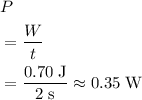
Chemistry, 15.12.2020 18:50 emily12403
A chipmunk (mass of approximately 1 kg) does push-ups by using a force of 5 N to elevate its center-of-mass by 6 cm in order to do 0.70 Joule of work. If the chipmunk does all this work in 2 seconds, what is its power?

Answers: 2
Another question on Chemistry

Chemistry, 21.06.2019 22:00
If 1.63 times 10 negative 4 of helium dissolves in 100.0g of water, what is the concentration in parts per million
Answers: 3

Chemistry, 22.06.2019 01:00
Look at the bean data from days 4–6. use these data to explain how natural selection changed the number of dark red walking beans over time. writing part
Answers: 3

Chemistry, 22.06.2019 04:00
Two nitro no2 groups are chemically bonded to a patch of surface. they can't move to another location on the surface, but they can rotate (see sketch at right). it turns out that the amount of rotational kinetic energy each no2 group can have is required to be a multiple of ε, where =ε×1.010−24 j. in other words, each no2 group could have ε of rotational kinetic energy, or 2ε, or 3ε, and so forth — but it cannot have just any old amount of rotational kinetic energy. suppose the total rotational kinetic energy in this system is initially known to be 32ε. then, some heat is removed from the system, and the total rotational kinetic energy falls to 18ε. calculate the change in entropy. round your answer to 3 significant digits, and be sure it has the correct unit symbol.
Answers: 2

Chemistry, 22.06.2019 09:00
The nuclear fission process releases neutrons and question 27 options: alpha particles electrons energy beta particles
Answers: 1
You know the right answer?
A chipmunk (mass of approximately 1 kg) does push-ups by using a force of 5 N to elevate its center-...
Questions






History, 05.09.2020 18:01



Mathematics, 05.09.2020 18:01


Mathematics, 05.09.2020 18:01

Mathematics, 05.09.2020 18:01

Mathematics, 05.09.2020 18:01

Mathematics, 05.09.2020 18:01





Mathematics, 05.09.2020 18:01

 on average.
on average. is equal to the product of force
is equal to the product of force  and the speed
and the speed  at which that force moves the object. That is:
at which that force moves the object. That is:  .On the other hand, average power
.On the other hand, average power  is done. In other words, average power
is done. In other words, average power  is the average work done in unit time. If work
is the average work done in unit time. If work  is done in time
is done in time  , the average power would be
, the average power would be  .
.  ) and the time required (
) and the time required ( ).
). .
. 

